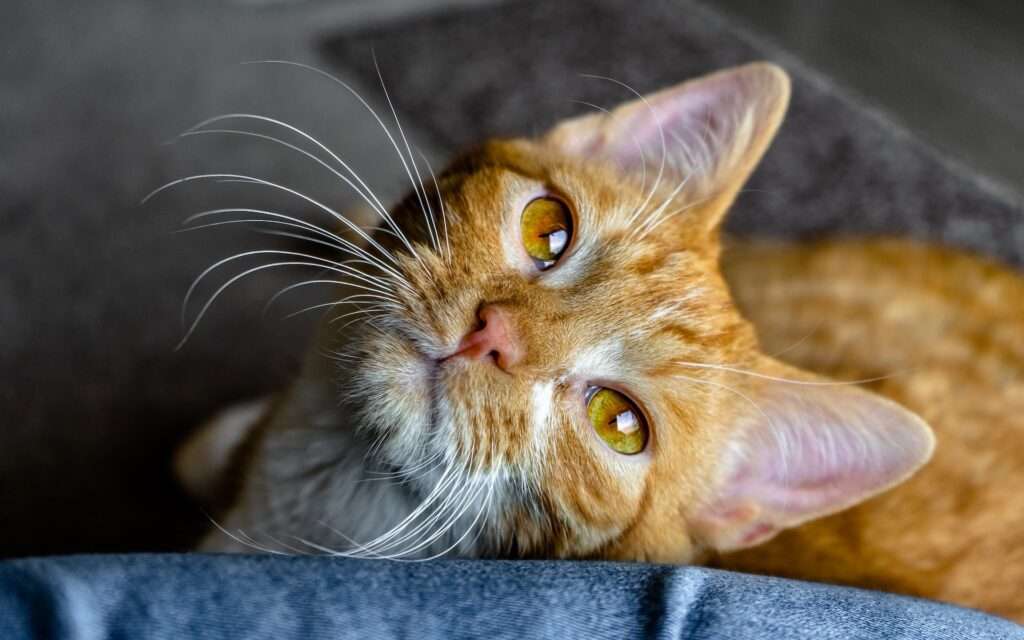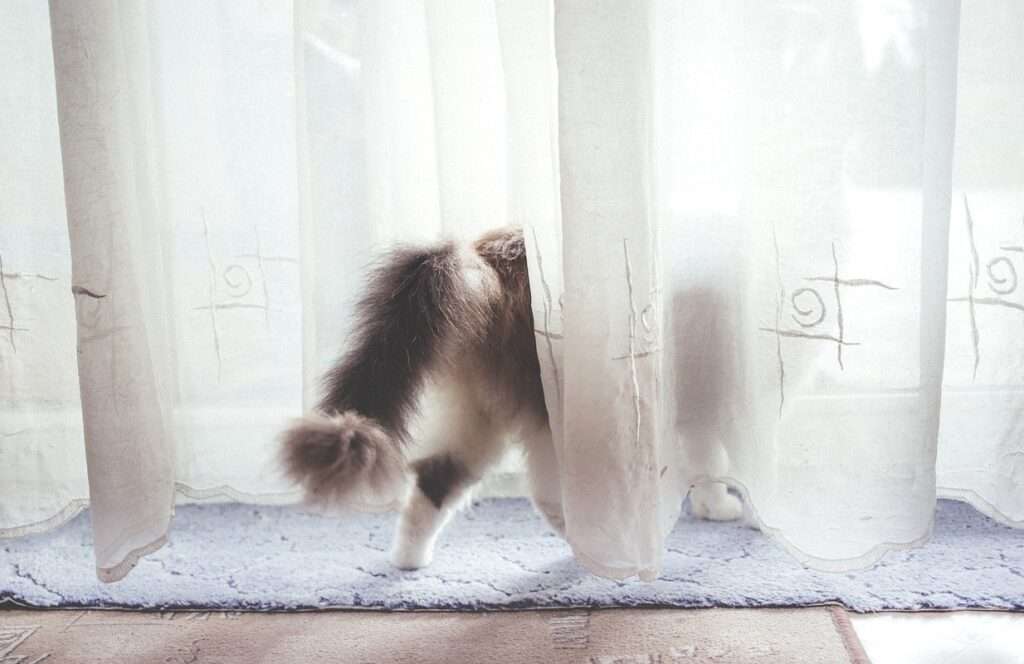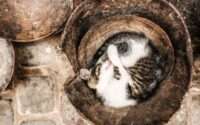Why Does My Cat Trill and Run Away? 6 Fascinating Explanations Revealed!
Your feline friend is a constant source of wonder, isn’t it? From their mesmerizing eyes to their enigmatic behavior, cats have a unique way of captivating our hearts. If you’ve ever found yourself wondering, “Why does my cat trill and run away?” – you’re not alone. It’s a question that many cat owners ponder as they seek to decode the mysterious language of their beloved pets.
In this informative article, we embark on a journey to unravel the secrets behind your cat’s trilling and running behavior. It’s a fascinating exploration into the world of feline communication and behavior. By the time you finish reading, you’ll not only understand the trill, but you’ll also be better equipped to strengthen the bond with your furry companion.
The Trilling Sound
Cats are renowned for their vocal repertoire, and trilling is a vocalization that often leaves us intrigued. Trilling is a unique, high-pitched, melodic sound that is distinct from the typical “meow” or “purr.” These adorable chirps and musical notes add an extra layer to feline communication. But what do they mean? Well, that’s what we’re here to uncover.
Trills come in different flavors, and each one has its own feline dictionary. These vocal cues are an essential part of your cat’s way of conversing with you. We’ll delve into the subtle nuances of these trills, explore the emotions and messages they convey, and even share some delightful video examples to help you decode the language of your trilling furball.
So, let’s embark on this enlightening journey to understand why your cat trills and runs away. The secrets of feline trilling are about to unfold, revealing a world of cat-human connection that’s both mystifying and heartwarming.
Cat Behavior
Cats are fascinating creatures, and their behavior is a rich tapestry of instincts, preferences, and individual quirks. To understand why your cat trills and runs away, we must first appreciate the intricate world of feline behavior.
- Overview of common cat behaviors: Cats exhibit a wide range of behaviors, from the endearing kneading of their paws to the aloofness of a catnap. Understanding these behaviors is like deciphering a unique code that allows us to connect with our furry friends on a deeper level.
- The importance of context in understanding feline actions: Cats’ actions are not arbitrary. They are often responses to their environment, emotions, and instincts. What might seem like a mysterious trill and dash may have a clear motivation when viewed in the right context.
- How cats communicate through body language: Cats are master communicators, and much of their messaging occurs through subtle body language. Their tails, ears, and even whiskers convey a wealth of information about their feelings and intentions. Understanding these non-verbal cues is crucial in comprehending your cat’s behavior.
- How cats communicate with vocalizations: Beyond body language, cats use vocalizations to communicate with us and other animals. Each meow, purr, and trill carries meaning. We’ll explore the various vocalizations and their potential significance, focusing on the unique trilling behavior that has piqued your curiosity.
Possible Reasons for Trilling and Running Away
Now that we’ve tuned our ears to the mesmerizing melodies of cat trills, it’s time to dive into the complex world of feline behavior. Our feline friends are known for their enigmatic nature, and their actions are often a result of multifaceted factors. When you hear that delightful trill followed by a hasty retreat, it’s not always straightforward. Here are some possible reasons for this intriguing behavior:
- Territory marking and social communication: Cats are territorial creatures. They use trills to declare ownership or convey social messages. Trilling and dashing away could be a way for your cat to establish boundaries or assert their presence.
- Hunting instincts and playfulness: The wild spirit of a hunter often resides in your domesticated cat. Trills can be a sign of excitement, perhaps triggered by a prey-like toy or the sight of something intriguing. The sudden retreat may be an invitation to join in the game of chase.
- Fear or anxiety: Cats are sensitive beings, and certain situations may make them feel anxious or fearful. A trill followed by fleeing could be your cat’s way of expressing discomfort or unease. Identifying the source of their anxiety is crucial.
- Stress or overstimulation: Just like humans, cats can get overwhelmed. If your feline friend feels overstimulated, they might trill as a way to release tension. Running away provides a means to escape the overbearing stimuli.
- Health issues: Sometimes, a cat’s trill and rapid exit could be due to physical discomfort. It’s essential to rule out any underlying health concerns when you notice changes in your cat’s behavior.
- Past experiences and trauma: Cats can be profoundly affected by past experiences. If your cat has faced trauma or had negative encounters, their trilling and evasiveness may be rooted in those memories.
Understanding Feline Body Language

Cats are master communicators, and they don’t rely solely on vocalizations to express themselves. Their bodies tell a story too. Understanding feline body language is like deciphering an ancient code that enhances your connection with your furry friend. Here’s a glimpse into the subtle cues your cat uses:
- Tail positions and meanings: A cat’s tail can be a barometer of its emotions. An upright tail signals confidence and contentment, while a puffed-up tail can indicate fear or aggression.
- Ear movements and their significance: Ears that are forward and alert suggest a cat is engaged and curious. Flattened ears, on the other hand, are a sign of agitation or displeasure.
- Pupil dilation and eye contact: The eyes are windows to a cat’s soul. Dilated pupils can mean excitement, while slow blinks are a sign of affection. Staring without blinking might be perceived as a threat.
- Whisker and facial expressions: Whiskers aren’t just stylish accessories; they’re sensory tools. If your cat’s whiskers are pulled back, they may be feeling anxious. A relaxed face with half-closed eyes is a content cat.
By understanding these non-verbal cues, you can gain deeper insights into your cat’s emotions and intentions. Now, let’s use this knowledge to unravel the mystery of why your cat trills and darts away. We’re on the path to becoming cat whisperers, deciphering their unique language one trill at a time.
Human-Cat Interactions
Now that we’ve delved into the captivating world of feline body language, let’s shift our focus to the intricate dance of human-cat interactions. Understanding how to engage with your cat is vital for fostering a harmonious relationship. After all, you and your cat are partners in this mysterious waltz of communication.
- Building trust and rapport with your cat: Trust is the cornerstone of any strong relationship. Cats can be cautious by nature, so it’s essential to respect their boundaries and give them the space they need to feel comfortable. Building trust involves patience, gentle interaction, and the willingness to let your cat come to you on their terms.
- The importance of patience and consistency: Cats thrive on routine and predictability. Consistency in your actions and reactions helps your cat feel secure. Be patient in your interactions, and remember that trust and understanding take time.
- Common mistakes to avoid in cat-human interactions: While your intentions may be pure, it’s easy to make mistakes when interacting with your feline friend. Avoiding sudden movements, respecting their personal space, and not overwhelming them with attention are some common pitfalls to steer clear of.
Observing Environmental Factors
Your cat’s behavior is influenced by their environment. The living space you provide can significantly impact their overall demeanor. Here’s a peek into the environmental factors that can affect your cat’s actions:
- Impact of the living environment on cat behavior: Cats are highly sensitive to their surroundings. A cluttered or noisy home may lead to stress, while a serene environment can promote relaxation. Ensuring your home is cat-friendly is essential for their well-being.
- The role of other pets and people in the house: Your cat’s interactions with other pets and people in your home can be a significant factor in their behavior. Whether it’s peaceful coexistence or occasional skirmishes, understanding these dynamics can help you decode your cat’s trilling and evasive maneuvers.
- Creating a cat-friendly home: Cats need spaces to call their own. Providing cozy spots for lounging, scratching posts for exercise, and safe hideaways can make your cat feel secure and content.
- Cat enrichment and playtime: Cats are natural hunters and explorers. Ensuring they have stimulating activities, toys, and playtime can help reduce boredom and anxiety, making them less likely to trill and run away due to pent-up energy.
By taking these environmental factors into account, you can create a space that promotes your cat’s well-being and reduces the likelihood of mysterious trills and hasty escapes. Your home can become a sanctuary where your feline friend feels truly at ease, and where the enchanting dance of human-cat interaction can flourish.
Health Concerns

In our quest to understand why your cat trills and dashes away, it’s essential to explore another critical dimension: the impact of health on feline behavior. Just like us, cats can experience physical discomfort, illness, or pain that influences how they interact with the world. Here are some crucial aspects to consider:
- How underlying health issues can influence cat behavior: Cats are masters at concealing their pain or discomfort. A cat that suddenly trills and runs away may be trying to cope with an undiagnosed health problem. It’s vital to be vigilant and observant, as behavioral changes can be subtle indicators of underlying health concerns.
- Common health problems that may cause trilling and running away: Health issues such as dental problems, urinary tract infections, or gastrointestinal distress can lead to changes in behavior. Understanding the signs and symptoms of these issues is essential in ensuring your cat’s well-being.
- The importance of regular veterinary check-ups: Prevention is always better than cure. Regular visits to the vet can help catch health problems early, before they lead to noticeable behavior changes. Discuss your cat’s behavior with your veterinarian to rule out underlying health issues.
Real-Life Stories: Cat Owners’ Experiences
Real-life examples often provide valuable insights into the mysteries of feline behavior. Let’s delve into a few case studies that showcase the diverse situations in which cats trill and run away, and how their owners successfully addressed and resolved these enigmatic behaviors.
- Whiskers the Playful Pouncer: Whiskers, a young and exuberant cat, would often trill and then engage in sudden bursts of playfulness. His owner, Jane, discovered that providing interactive toys and designated play sessions helped channel Whiskers’ energy in a positive way, reducing his trilling episodes.
- Bella the Anxious Adventurer: Bella had a history of living on the streets before being adopted. She would trill and dash away when she felt overwhelmed. Her owner, Alex, created safe spaces and a structured routine to help Bella feel secure, ultimately reducing her anxiety-driven trills.
- Oliver’s Playful Trills: Emma, a cat parent, shares, “Oliver, my mischievous tabby, trills like a tiny bird when he wants to play. He’ll run into the room, make those adorable sounds, and then zoom away. It’s our cue for playtime. We’ve bonded over these playful trills, and they’ve become a cherished part of our daily routine.”
- Luna’s Anxious Trills: Another cat owner, Mark, tells us about Luna, his shy Siamese. “Luna used to trill and run off whenever guests visited. We realized it was her way of coping with social anxiety. We created a safe space for her in our bedroom, where she could retreat when she felt overwhelmed. Gradually, her trills decreased as she grew more comfortable with visitors.”
By examining these real-life scenarios, you can glean insights into how other cat owners tackled similar issues and found solutions to the trilling and running away conundrum. Your cat’s unique story may share some common threads with these cases, helping you find the right path to address their behavior.
As we journey through these case studies, it becomes evident that there’s no one-size-fits-all answer to why your cat trills and runs away. Each cat has its unique personality, history, and needs. Understanding their specific context is key to unraveling the mystery and nurturing a healthier, more fulfilling relationship with your feline companion.
Behavioral Training and Modification
The previous case studies have given us a glimpse into the diversity of reasons behind cat trilling and running away. Now, let’s explore strategies for addressing and modifying these behaviors. Every cat is a unique individual, and tailoring your approach to their specific needs is the key to success. Here are some techniques for behavioral training and modification:
- Techniques for modifying undesirable behaviors: If your cat’s trilling and running away is causing issues, it’s important to consider strategies for behavior modification. This might include redirecting their energy through play, positive reinforcement, or the introduction of calming techniques.
- Positive reinforcement and clicker training: Cats respond well to positive reinforcement. Rewarding desired behaviors with treats or affection can encourage your cat to change their conduct. Clicker training is also a valuable tool for conditioning your cat to associate the trill with positive outcomes.
- When to consult a professional behaviorist: In some cases, behavioral issues may persist despite your best efforts. In such instances, consulting a professional cat behaviorist can be a wise decision. They possess the expertise and experience to address complex feline behavior problems and provide tailored solutions.
Conclusion
In our quest to decipher the mysteries behind “Why Does My Cat Trill and Run Away?” we’ve embarked on a captivating journey through the world of feline communication and behavior. We’ve learned that trills aren’t just charming sounds; they are a vital part of how your cat expresses themselves.
Throughout this exploration, we’ve delved into the emotional spectrum of cat trills, examined common scenarios, and offered practical tips for understanding and managing this delightful behavior. We’ve celebrated the bond that trills can foster between you and your cat, highlighting how they enhance the feline-human connection.
As we conclude our journey, it’s essential to remember that every cat is unique, and their trilling behavior may have its own nuances and meanings. By staying attuned to your cat’s cues and fostering a loving and understanding relationship, you’ll continue to unravel the beautiful mysteries of your feline companion.
Frequently Asked Questions
Why does my cat trill and run away?
Your cat’s trilling and running away can have multiple causes. It may be a form of communication, a response to excitement, anxiety, or a past experience, or even a sign of underlying health issues. Understanding your cat’s unique context is key to unraveling the mystery.
Is trilling a common cat behavior?
Trilling is a less common vocalization compared to meowing, but it’s not rare. Some cats trill more frequently than others, and it often reflects their individual personalities and communication style.
How can I tell if my cat’s trilling is due to fear or anxiety?
If your cat’s trilling is accompanied by flattened ears, dilated pupils, or a crouched posture, it could be a sign of fear or anxiety. Consider the context and any recent changes in the environment to identify potential stressors.
Can I train my cat to stop trilling and running away?
While you can modify your cat’s behavior through training, it’s essential to do so with positive reinforcement and patience. Trilling is a natural form of communication, and abrupt changes may not be effective. Consult with a professional behaviorist if needed.
Are some cat breeds more prone to trilling?
Trilling isn’t exclusive to any particular cat breed, but some breeds, such as Siamese and Burmese cats, are known for their vocal nature. Individual personality and upbringing often play a more significant role in a cat’s propensity to trill.
When should I consult a veterinarian regarding my cat’s trilling behavior?
If you notice a sudden, unexplained change in your cat’s behavior, particularly if it’s accompanied by signs of illness or discomfort, it’s crucial to consult a veterinarian. They can rule out any underlying health issues that may be causing the behavior change.
Can I use clicker training to address my cat’s trilling and running away?
Clicker training can be a valuable tool in modifying your cat’s behavior, including trilling. Associating the trill with positive reinforcement using a clicker can help encourage desired actions while strengthening your bond with your cat.
How can I create a cat-friendly home environment?
Designing a cat-friendly home involves providing spaces for rest, play, and exploration. Scratching posts, cozy resting spots, interactive toys, and a consistent routine can help your cat feel secure and content.
Is it normal for my cat to trill when playing with toys or during interactive play?
Yes, trilling during play is common and usually indicates excitement and enjoyment. It’s your cat’s way of expressing enthusiasm and can be a sign of a healthy, happy feline.
What’s the best way to build trust and rapport with my cat?
Building trust with your cat requires patience, consistency, and respect for their boundaries. Spend quality time with your cat, offer treats and affection, and let them initiate interactions on their terms to strengthen your bond.





